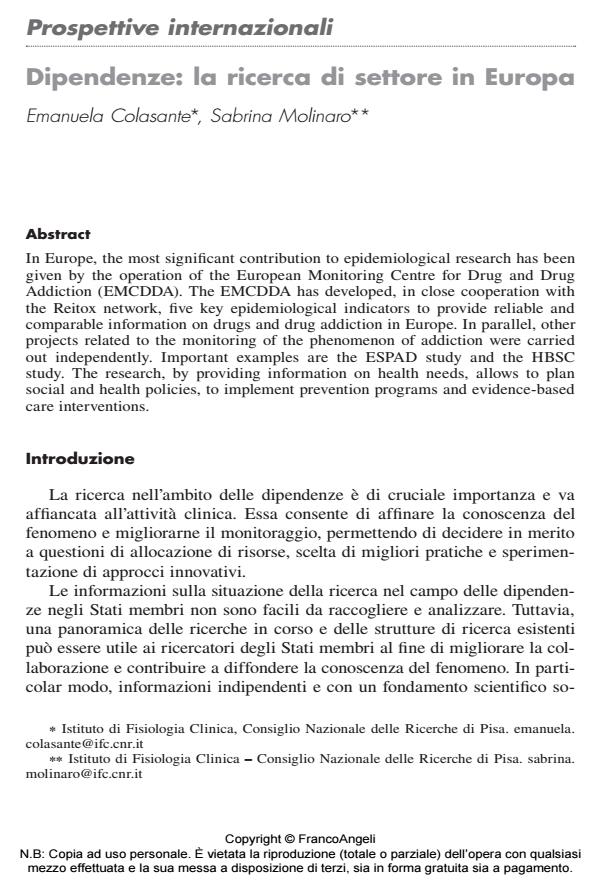Dipendenze: la ricerca di settore in Europa
Titolo Rivista SICUREZZA E SCIENZE SOCIALI
Autori/Curatori Emanuela Colasante, Sabrina Molinaro
Anno di pubblicazione 2014 Fascicolo 2014/3 Lingua Italiano
Numero pagine 15 P. 167-181 Dimensione file 120 KB
DOI 10.3280/SISS2014-003013
Il DOI è il codice a barre della proprietà intellettuale: per saperne di più
clicca qui
Qui sotto puoi vedere in anteprima la prima pagina di questo articolo.
Se questo articolo ti interessa, lo puoi acquistare (e scaricare in formato pdf) seguendo le facili indicazioni per acquistare il download credit. Acquista Download Credits per scaricare questo Articolo in formato PDF

FrancoAngeli è membro della Publishers International Linking Association, Inc (PILA)associazione indipendente e non profit per facilitare (attraverso i servizi tecnologici implementati da CrossRef.org) l’accesso degli studiosi ai contenuti digitali nelle pubblicazioni professionali e scientifiche
In Europe, the most significant contribution to epidemiological research has been given by the operation of the European Monitoring Centre for Drug and Drug Addiction (EMCDDA). The EMCDDA has developed, in close cooperation with the Reitox network, five key epidemiological indicators to provide reliable and comparable information on drugs and drug addiction in Europe. In parallel, other projects related to the monitoring of the phenomenon of addiction were carried out independently. Important examples are the ESPAD study and the HBSC study. The research, by providing information on health needs, allows to plan social and health policies, to implement prevention programs and evidence-based care interventions.;
- Currie C et al. (eds.) (2012). Social determinants of health and well-being among young people. Health Behaviour in School-aged Children (HBSC) study: international report from the 2009/2010 survey. 2009/10 International Report:
- Social determinants of health and well-being among young people. Copenha gen: WHO Regional Office for Europe, 2012 (Health Policy for Children and Adolescents, No. 6).
- EMCDDA (2014). European Drug Report 2014: Trends and developments. Lisbon: EMCDDA.
- EMCDDA (2012). Treatment demand indicator (TDI) standard protocol 3.0: Guidelines for reporting data on people entering drug treatment in European countries. Lisbon: EMCDDA.
- EMCDDA (2012). Mortality cohort guidelines. Lisbon: EMCDDA.
- EMCDDA (2010). Standard protocol to collect data and report figures for the key indicator drug-related deaths (DRD-Standard, version 3.2). Lisbon: EMCDDA.
- EMCDDA (2009). An overview of the drug-related infectious diseases (DRID) key indicator. Lisbon: EMCDDA.
- EMCDDA (2004). Guidelines for the prevalence of problem drug use (PDU) key indicator at national level. Lisbon: EMCDDA.
- EMCDDA (2002). Handbook for surveys on drug use among the general population. Lisbon: EMCDDA.
- EMCDDA (1999). Guidelines for the prevalence of problem drug use (PDU) key indicator at local level. Lisbon: EMCDDA.
- Hibell B., Guttormsson U., Ahlström S., Balakireva O., Bjarnason T., Kokkevi A.,
- Kraus L. (2012). The 2011 ESPAD Report. Substance Use Among Students in 36 European Countries. Stockholm: The Swedish Council for Information on Alcohol and Other Drugs (CAN).
Emanuela Colasante, Sabrina Molinaro, Dipendenze: la ricerca di settore in Europa in "SICUREZZA E SCIENZE SOCIALI" 3/2014, pp 167-181, DOI: 10.3280/SISS2014-003013